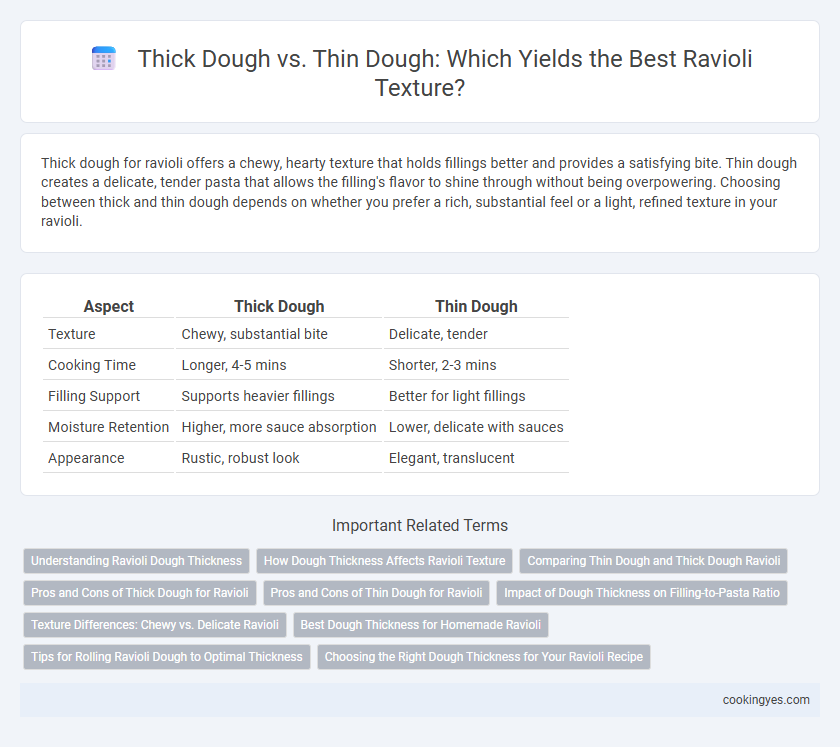Thick dough for ravioli offers a chewy, hearty texture that holds fillings better and provides a satisfying bite. Thin dough creates a delicate, tender pasta that allows the filling's flavor to shine through without being overpowering. Choosing between thick and thin dough depends on whether you prefer a rich, substantial feel or a light, refined texture in your ravioli.
Table of Comparison
| Aspect | Thick Dough | Thin Dough |
|---|---|---|
| Texture | Chewy, substantial bite | Delicate, tender |
| Cooking Time | Longer, 4-5 mins | Shorter, 2-3 mins |
| Filling Support | Supports heavier fillings | Better for light fillings |
| Moisture Retention | Higher, more sauce absorption | Lower, delicate with sauces |
| Appearance | Rustic, robust look | Elegant, translucent |
Understanding Ravioli Dough Thickness
Thick dough for ravioli provides a chewy, hearty texture that holds rich fillings well, offering a satisfying bite with every mouthful. Thin dough creates a delicate, tender wrapper that highlights the filling's flavor while cooking quickly and evenly. Understanding the impact of dough thickness helps achieve the perfect balance between texture and taste in traditional ravioli.
How Dough Thickness Affects Ravioli Texture
Thick dough in ravioli creates a chewier, more substantial texture that holds up well with robust fillings and hearty sauces. Thin dough results in a delicate, tender bite that allows the filling's flavors to shine through, offering a lighter overall experience. Balancing dough thickness is crucial to achieving the desired mouthfeel and ensuring even cooking without compromising the ravioli's structural integrity.
Comparing Thin Dough and Thick Dough Ravioli
Thin dough ravioli offers a delicate texture that highlights the filling, allowing flavors to shine while maintaining a tender bite. Thick dough ravioli provides a heartier, chewier experience that can support robust fillings and richer sauces without falling apart. Choosing between thin and thick dough depends on the desired balance of texture and the intensity of the filling inside the ravioli.
Pros and Cons of Thick Dough for Ravioli
Thick dough for ravioli offers a robust, chewy texture that holds fillings securely and provides a heartier bite, enhancing the overall eating experience. It is less prone to tearing during filling and cooking, making it ideal for robust or chunky fillings but may overpower delicate flavors and result in a denser mouthfeel. However, thick dough requires longer cooking times and can mask subtle ingredients inside, which may not suit every ravioli variety.
Pros and Cons of Thin Dough for Ravioli
Thin dough for ravioli offers a delicate texture that allows the filling's flavor to stand out prominently, enhancing the overall taste experience. It cooks quickly and evenly, creating a tender bite, but risks tearing easily and losing filling if not handled with care. Thin dough requires precise technique to maintain structural integrity while delivering a light, refined texture favored in gourmet ravioli preparations.
Impact of Dough Thickness on Filling-to-Pasta Ratio
Thick dough in ravioli creates a more substantial texture but reduces the filling-to-pasta ratio, making the pasta more prominent than the filling. Thin dough allows the filling's flavors and moisture to shine through, enhancing the overall taste experience by balancing the pasta and filling evenly. Optimal dough thickness ensures the ravioli remains tender while providing sufficient filling without overpowering the delicate pasta layer.
Texture Differences: Chewy vs. Delicate Ravioli
Thick dough ravioli offers a chewy texture that provides a hearty bite, ideal for robust fillings like meat or mushroom blends. Thin dough ravioli results in a delicate, tender mouthfeel that allows the filling's flavors to shine through without overwhelming the palate. The choice between thick and thin dough directly impacts the overall eating experience, balancing chewiness against subtlety in texture.
Best Dough Thickness for Homemade Ravioli
The best dough thickness for homemade ravioli strikes a balance between durability and tenderness, typically around 1 to 1.5 millimeters. Thick dough offers a chewy texture and robust structure, preventing fillings from leaking during cooking, but can overwhelm delicate fillings. Thin dough results in a lighter, more elegant bite that highlights the filling, though it requires careful handling to avoid tearing.
Tips for Rolling Ravioli Dough to Optimal Thickness
Achieving the optimal ravioli texture depends on rolling the dough to the right thickness; thick dough yields a chewier bite while thin dough offers a delicate, tender mouthfeel. For ideal thickness, roll the dough to roughly 1/16 inch, ensuring it's thin enough to showcase the filling without tearing. Use a lightly floured surface, apply even pressure with a rolling pin, and rotate the dough frequently to maintain consistent thickness and prevent sticking.
Choosing the Right Dough Thickness for Your Ravioli Recipe
Choosing the right dough thickness for ravioli is crucial to achieving the perfect texture and cooking performance. Thick dough offers a hearty, chewy bite that complements robust fillings and holds up well to boiling, while thin dough highlights delicate fillings and creates a tender, melt-in-your-mouth experience. Balancing dough thickness with the filling's moisture content ensures optimal cooking time and prevents the ravioli from bursting or becoming too dense.
Thick dough vs Thin dough for ravioli texture Infographic

 cookingyes.com
cookingyes.com